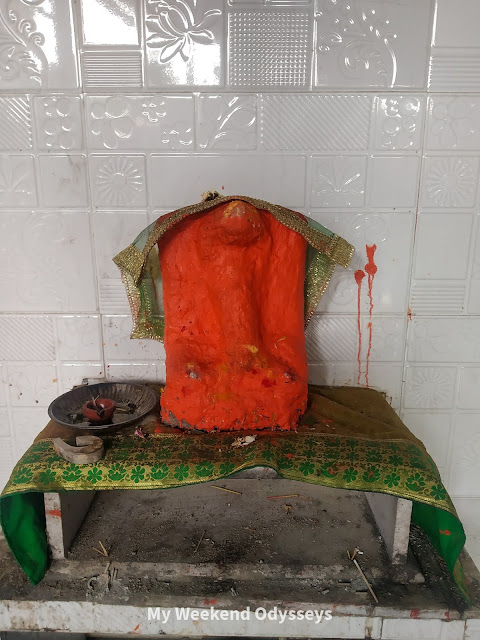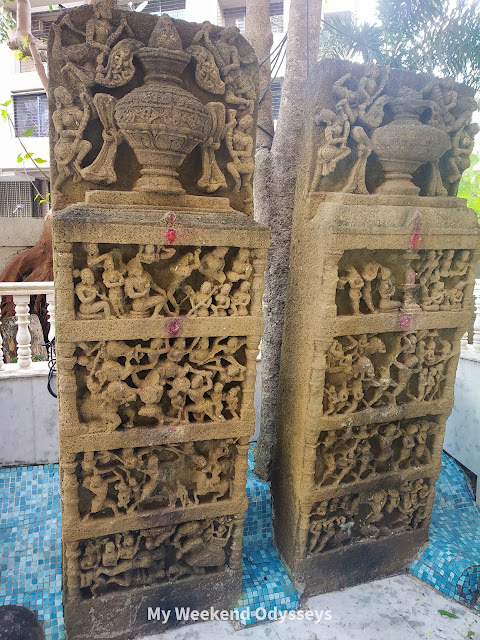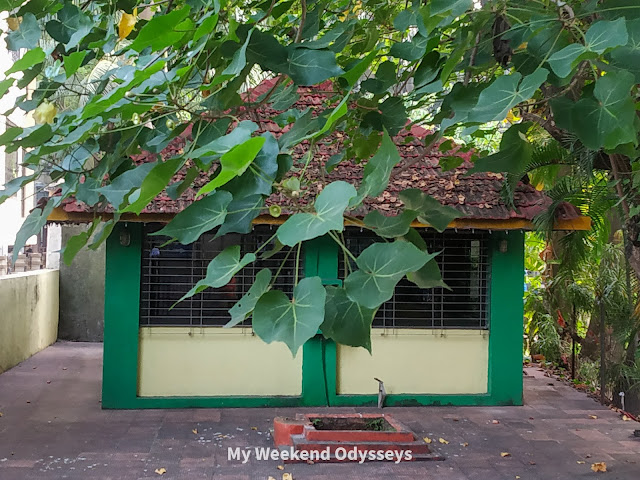The patron goddess (gaondevi's) of lost villages in suburban neighbourhood of Borivali
"Berewlee" known during British Era is one of the suburban station that we know today as Borivali, One of the most affluent suburb in Mumbai. The name comes from bushes of "bor" (sweet berries) which were found in abundance here hence it was called the "Land of sweet berries (ber)". Once situated between two rivers - Poisur river on the south and Dahisar river on the north. The suburb of Borivali was a congregation of small villages or gaonthan's with huge wadi's having lots of Mango and Chickoo trees. The 8th century Mandapeshwar rock cut caves as well as the 1st century to 10th century built group of caves known as Kanheri in the deep forest of Sanjay Gandhi National park stands testament and speaks highly of the rich history of the place.
Eksar, Poisur, Vazira, Babhai, Shimpoli, Mandapeshwar, Kanheri, Tulsi, Magathane, Gorai, Culvem were few villages or hamlets which today collectively have become suburb of Borivali. Apart from these bigger villages, there were hamlets or pakhadi's like Eksar Tale pakhadi, Thakur pakhadi, Mhatr pakhadi, Muddhan pakhadi, Church pakhadi etc...
These gaonthan's had its own place of worship like temples and churches. Among the temples dedicated to various god's and goddess, there were gaondevi's (temple dedicated to patron goddess of the village). Over the years the villages have disappeared, areas have merged and suburb is today an affluent neighbourhood with high rise buildings. But hidden amidst our big urban village called Borivali, We still come across areas which have retained the name "gaonthan's" and there are few last remaining temples called "gaondevi's". Most of these temples have been rebuilt, renovated so much so that old idols of the goddess in some have been replaced with newer ones. So in my heritage walk I set out to trace some of these gaondevi's in my neighbourhood which have existed from many decades and in some cases over a century.
Chinchpada gaondevi: One such temple is located in Chinchpada area of Borivali east. The gaondevi temple is a small temple, nothing fancy about it but unique in a way. The idol's worshiped in the temple are few round stones popping out of the ground. These stones have been smeared in vermilion and worshiped as Gaondevi. Erstwhile settlement has given way to multi storied buildings but the temple stands at the same very spot where it used to be earlier, right in middle of the road.
Harsiddhi devi temple: This goddess temple would have once stood deep inside the forest of national park but over the years the forest borders shrank and it today stands in a narrow street of densely populated area of "Jai Maharashtra nagar" in Borivali east. The ancient temple is dedicated to the goddess Harsiddhi is considered as an aspect of goddess Durga and is popular temple in states of Gujarat and Madhya Pradesh.
The main idol has only the face of main goddess Harsiddhi along with two other goddess and is situated in beautifully decorated sanctum sanctorum. She is considered to be "kuldevi" of many brahmin, rajput communities including the erstwhile royal family of princely state of Rajpipla. The temple courtyard has few other shrines including a Naga stone as well as remnant of an old temple structure.
Just outside the temple under a huge tree lies two stones which seems to be part of old temple structure.
Gaondevi of Devipada: This goandevi temple located in a locality situated in east of Borivali. Devipada area has a maze of very narrow alleys and street with zillion homes and buildings, once you have successfully moved past them, you come across an open ground known as gaondevi ground. The gaondevi temple is located in the ground. The temple is a very simple neighbourhood place of worship, frequented almost entirely by the locals. But once you enter the temple lies the surprise, the main idol which is worshipped as gaondevi is actually a herostone. (Herostone's are memorial stones built in tribute to a warrior killed in some battlefield.).
Ekvira devi: This gaondevi is quite unique and most precious ancient relic to be found in Borivali. Located in Borivali west close to Eksar village. These stones were found in a small pond near the village which locals fished out and installed it on its banks. Over a period of time a high rise building was constructed at the spot but luckily they provided a separate spot within the compound for these ancient relics. Koli community of Eksar village worship them as their gaondevi - Ekvira devi. These stone relics are "veergals" with intricate carvings made from basalt rocks. About 8 ft tall, these stones were built as tribute to warriors of Shilahara dynasty navy.
I have written a separate blog on the Herostone's of Borivali in much details. (Veergals of Borivali )
Shimpoli gaondevi: Shimpoli is today one of the most sort after localities today but ask someone where is Shimpoli gaonthan and most likely the reply would be a blank stare !!. Shimpoli gaonthan's last remaining bastions is one single street which has few bungalows while others have given way to storied buildings. Nothing of bygone era remains except in one corner of a small street near a small pond lies the gaondevi of Shimpoli.
The temple also has undergone changes in its structure and new idol of the goddess now sits in the main sanctum. But what catches the eye are some figures in stone, colored in red, placed on both the sides of main idol. One local lady informed me that one of the figurine is brother while others are the "sathidars or family" of the goddess.
The temple is located in a very peaceful surrounding with a small water body next to it and a small nursery in the compound brings the much needed greenery around the temple.
The sign board on the entrance of the street indicating that the direction of the gaondevi temple.
Posai Mata temple: The temple is considered to be a family deity of Chogle family who once owned large tracts of land in Borivali. Managed by temple trust of the family, it is located in a corner of a public garden in Babhai village.
The temple is inaccessible and rarely visited by public as it is always closed except when the priest from nearby temple which is also managed by Chogle family trust opens it twice a day to offer prayers.
Eksar Gaondevi temples: Eksar gaonthan was one of the biggest villages in terms of area and had many small hamlets or pakhadis scattered within it. Even today one can find traces of these pakhadis with old houses and narrow streets. These erstwhile settlements like Thakur pakhadis, Mhatr pakhadis ,Tale pakhadis as well as Eksar koliwada still exist even today and retain their identity, But they have also like all other gaonthan's merged into one big suburb of Borivali.
Two of these pakhadis (Mhatr and Tale) have their own gaondevi temples situated on either side of a small lake. Over the years both the temples have been renovated leaving no trace of the old temple structure. (pics will be uploaded soon).
Mumbai may have galloped from sparsely populated seven islands to one of the most densely populated mega metropolis but still hidden amidst high rises lies our heritage in gaonthan's and gaondevi's, So next time you come across any gaondevi temple while passing any locality in Mumbai, do remember it could have been the protective deity of erstwhile village lost in oblivion in our quest for urbanisation. !!


























Comments
Post a Comment